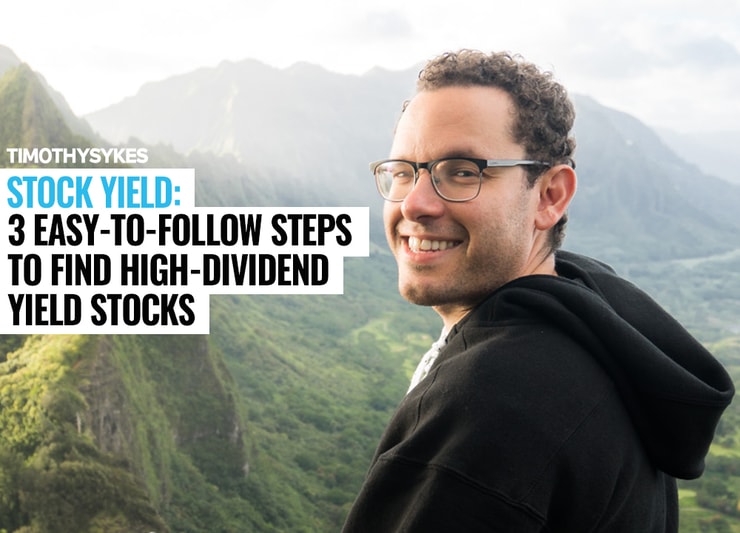Wouldn’t you love to make extra money by just holding a position in a stock?
Like the idea of regular payouts and the potential for steady growth? High-dividend yield stocks might be up your alley …
Stocks that offer a dividend yield can allow you to rely on cash distributions instead of keeping track of percentages to allocate for reinvestment. In other words: money coming in for (somewhat) minimal effort.
In terms of building your account, this can be a reliable and effective long-term strategy.
In this post, you’ll get an education on stock yield to help you find high-dividend yield stocks. You’ll also learn what to look for and how to help protect your bottom line when choosing stocks to trade.
Table of Contents
What Is Stock Yield?
Before you learn how to find stocks with a high yield, you need to understand what yield actually is — and what it isn’t.
Stock yield is the earnings that accumulate on a stock over a period of time. A stock’s yield is a simple ratio: the annual dividend divided by the share price.
The yield is listed as a percentage, which is based on the amount you’ve invested and the current market value of the stock.
Say there’s a stock paying $2 in dividends for the next year, and the current trading price is $100. That dividend yield is 2%.
A stock’s yield includes the amount of interest or dividends received.
Here’s another key point and common misunderstanding …
Yield and return are not the same thing!
Remember it this way: A return is in the past. This is the amount you earned on a stock during a period of time that’s already passed — including interest, dividends, and possibly capital gains.
Yield, on the other hand, looks to the future. It includes interest and dividends but not capital gains. It’s annualized based on a time period, assuming that the interest/dividends will continue at a similar rate.
Importance of Looking at Stock Yield
Now that you understand what stock yield is, why should you look at it?
That’s easy: The yield can be a great investment indicator.
A higher yield means that you can potentially have more cash flowing into your investment.
High yield typically follows high dividends, which can be a sign of high earnings. That can keep stock prices high.
But you have to consider why the yield is calculated at a particular percentage.
A very high yield may be due to the stock losing value.
So, what if the yield is high, but the stock price hasn’t gone up in kind? This can indicate that the company in question is paying dividends without increased earnings to back it up. That can be a red flag and spell trouble ahead.
Yep … if it sounds too good to be true, it probably is. Just because a stock has a high yield, that doesn’t guarantee you’ll make money.
What Are High-Dividend Yield Stocks?

2025 Millionaire Media, LLCLet’s keep building! What are high-dividend yield stocks?
You already understand yield, so let’s do a little refresher on dividends so you can see how it all fits together …
A dividend is a company-issued payment to shareholders. A dividend can be issued as cash (called ‘cash dividends’) or as stock (called ‘stock dividends’).
Usually, dividends are paid quarterly. This isn’t always the case though. Sometimes a big event like a merger or huge increase in sales can act as the cause for a single dividend payout.
Dividend payments and yield are tied together. Remember that the yield measures the dividend relative to the price per share.
It’s worth noting: Dividends are most frequently associated with large-cap companies. That’s because, in general, they lack the volatility of lower-priced stocks. Therefore, the prices don’t move as rapidly or in sudden spikes.
While this slow-but-steady growth model may be reliable, it’s not going to build an account quickly. So, as an added incentive for investing in their company, these larger businesses are more likely to offer dividends.
And as a shareholder, you’re on the receiving end of these dividends. That can be a great benefit.
Putting it Together: High-Dividend Yield Stocks
So … if you put it all together, high-dividend yield stocks are pretty much exactly what they sound like: stocks that offer a higher rate of return with their dividends.
But now you’re probably wondering: What’s a good dividend yield?
Ultimately, it depends on the market. There’s no black-and-white rule, no dividing line, or specific percentage that differentiates between high- versus low-dividend yield.
A high yield in today’s market might seem low compared to the yields of a few years ago. In a few years, what we now call a high yield might seem very low.
At the time of this writing, many financial analysts and articles would probably rate 4% or higher as a high yield, though some might go higher or lower.
If you want a more current snapshot of dividend yields, check out the highest dividend stocks on the NASDAQ.
And, again, remember: A good yield doesn’t always mean it’s a good stock to buy.
Just because a stock has a high-dividend yield doesn’t automatically make it good, nor does a low one make a stock bad.
A very high dividend yield can be an indication that it’s a riskier stock to trade. A big yield can signal plump rewards — but that can mean a higher risk level too.
More Breaking News
- STEC on the Rise: What Investors Need to Know
- Foresight’s Stock Surge: Time to Reflect?
- MAra’s Potential Dip: Time for Reflection?
Benefits of Trading High-Dividend Yield Stocks
Are high-dividend yield stocks worth your time? Here’s what you gotta look for …
Consistent Income
This is one of the biggest lures of a high-dividend yield: the promise of consistent income.
Dividends are paid quarterly, meaning they can provide a steady, reliable added income source for you.
You don’t have to do anything special to earn them. So, in a way it feels like ‘free money.’ Use it to reinvest in more of the same stock or pad your bank account.
Trading in dividend-yielding stocks is part of a retirement strategy for many people. There are two key ways to do this: Through the increasing price of the stock and from company distributions.
Lots of companies may offer reinvestment plans for dividends. That makes it easier for you to use your dividend earnings to buy additional shares from the same company.
And there can be added incentives for reinvesting, like a discount on the stock. So, over time, you’ll earn more dividends because you have more shares that are earning them.
It’s a win-win. You, as the investor, can benefit from slow-but-steady growth, and the company has a better guarantee that you’ll stick with them for the long haul.
Strong-Performing Companies
Often enough, the fact that a company even offers dividends is usually an indication that it’s a strong performer.
Why? Because, generally, dividends are offered by large-cap companies. Think industry leaders here — their success is no accident.
Down side: When it’s a big, steady company, the stock price won’t move in a big way.
This isn’t necessarily a bad thing. It means that investing in a company like this is less risky. Offering dividends is a means to tempt and keep shareholders.
It’s kinda like a free gift with purchase at department stores: a little perk for shopping.
As the shareholder, you can enjoy the perks of the dividend yield — and the benefits of a strong-performing and stable company.
3 Easy-to-Follow Steps to Find High-Dividend Yield Stocks
Finding companies that offer high-dividend yield stocks is easy … when you use a screener.
A platform like StocksToTrade can help you filter for companies that might meet the dividend-yield percentages you’re looking for.
But how do you figure out which ones make good tactical sense? What’s right for you to trade now?
You can start by filtering by stocks that offer a dividend yield of 4% or higher (give or take).
After you set your filter, you’ll probably see a trend. Lots of these companies will likely fall in certain sectors — energy, utilities, consumer products, or real estate.
Depending on your background and experience, you might decide to focus on one particular sector or type of company.
From there, use these steps to narrow down your choices even further …
#1 News Catalysts
News catalysts are any number of company events that can move the price of a stock.
That can be an earnings win or an earnings report. If the company exceeds expectations, that can spark huge interest in the stock. The resulting spike can last for days.
Another catalyst can be a big investment. Say a notable investor pumps a big cash infusion into a company … that can be a sign that the company is poised for growth in the near future.
All kinds of news — both good and bad — can have an effect on the stock (think new products, contracts, etc.). Look for news catalysts that can have a positive impact on a stock with a high-dividend yield for the potential to maximize profits.
#2 Fundamental Analysis
It’s important to identify companies that either are profitable now, or that you think will be profitable in the future.
When you’re looking for ideal high-dividend yield stocks to trade, the earnings reports is one of the key tools you need to use for fundamental analysis.
A company’s earnings report is kind of like its diary: it gives you insight to its inner workings. Use it to help you make informed decisions about potential trades.
Don’t miss this key information! As a trader, you’d be foolish to not use this tool …
Earnings reports are public and free to access. They’re full information about the company’s performance, finances, and future direction.
You’ll also get a full view of the company’s debt, income, sales, and EPS (earnings per share).
You can use the earnings report to compare the company’s performance against itself: Do a side-by-side comparison of the most recent quarter against past ones.
And there’s also what analysts have to say about the earnings. Just reading about what a company has done is one thing, but how they performed against analysts’ projections can affect the stock too …
If a company meets or exceeds earnings expectations, that can have a great effect on the stock and create momentum. But if a company doesn’t meet projections, it can drive the price down.
Earnings reports must be filed and released to the public by set dates, or what’s referred to as ‘earnings season.’
Don’t just sit by and wait for the earnings report. Find out exactly when a company will release their earnings by reaching out to them for the most up-to-date window. Checking out earnings as soon as they’re released can give you an edge.
Reviewing the earnings report is part of your fundamental research, but you should also round it out by thoroughly vetting the company. That includes fact checking, reviewing press releases, and researching news about the company.
#3 Technical Analysis
You can’t rely on fundamental analysis alone. To make a well-informed decision about a high-dividend yield stock, you gotta back up your fundamental research with some detailed technical analysis.
Stock Chart Patterns
Show me the charts! Earnings reports are fine and good, but charts allow you to look at the price action over time.
When you look at a stock’s chart over time, chances are you’ll see patterns emerging in the price action.
Seeing patterns that repeat multiple times? Chances are they’ll continue to repeat in the future.
But don’t you dare go on your gut alone. Plan out your entry and exit points using fact-based knowledge.
Top Dividend Yield Stock Examples
Let’s break it down a little more … here’s a closer look at the difference between a company that offers a high-dividend yield and one that doesn’t. I want you to see the advantages and disadvantages of each!
AT&T Stock Dividend Yield
At the time of this writing, the dividend yield for AT&T (T) is 7.21%. That’s way higher than the technology average, which is about 1.32%, according to Dividend.com.
Should a number like that scare you or make you think it’s too high? Not necessarily.
Look at the company’s history: They have 33 years of steady dividend growth, which is a great indicator that the company will continue to deliver strong dividends.
Amazon Stock Dividend Yield
Amazon (AMZN) proves that not all large-cap companies need to offer dividends to entice investors.
Returns on this stock have been impressive over the years … but no dividends offered.
That’s not necessarily a bad thing, though. They use their income in productive ways: developing the business and expanding.
Just look at Amazon’s $13 billion purchase of Whole Foods. It brought Amazon into an entirely new retail — the brick and mortar market — which can offer a rising stock price for shareholders.
It might seem like Amazon should offer dividends based on its size alone. But the company offers other benefits to investors. Maybe because of this, in spite of its massive size, Amazon is still often considered a growth stock.
Key Tips to Analyze a Company Stock Yield

2025 Millionaire Media, LLCWhen analyzing a company’s stock yield and trying to decide which contenders from your watchlist are the most promising, keep these tips in mind …
Do Your Own Research and Don’t Trust Promoters
Don’t believe the hype! Too many traders learn this lesson the hard way. They sign up for a hot stock list, read websites, or follow the lead of stock promoters.
Sure, maybe a promoter really does have your best interests at heart and wants you to earn insane profits.
But it’s far more likely and common that they’re looking out for themselves.
You can only truly rely on your own thorough research.
It’s a great idea to follow other traders and even promoters for ideas on what’s trending in stocks and identifying hot sectors.
However … never, never, never execute a trade just because someone says it’s a good idea.
You’ll never get all trades right all the time. It’s just not possible with so many factors at play in the market. But you can at least rest assured knowing that you did your best and looked at every angle through fundamental and technical research.
High-dividend yield stocks aren’t without their fair share of risk. Be sure to dot your i’s and cross your t’s. Don’t let laziness keep you from making the most of every trade.
Yep, research can be tedious, but there will never be a point where it’s not necessary for you as a trader. Ever.
Stick to Your Trading Plan and Favorite Indicators
As you develop as a trader, you’ll have your own ‘bread and butter’ setups — things you look for in potential trades. Keep a list of your favorite indicators, and run them for every stock.
This is something I do in my Trader Checklist video series. I have several criteria that every trade must meet to a strong degree, or I won’t make the trade. No matter how tempting it is.
Let these indicators be your own personal checks and balances, helping you make smart choices.
Take your intelligence one step further and make a trading plan for every single trade. I almost feel like I need to repeat that or tell you to spray paint it on your walls … trading plan, trading plan, trading plan!
A trading plan is like an outline for your trades: It details your goals, why you’ve chosen the stock, and why this trade is a good idea.
It includes every necessary detail — your entry and exit, where you’ll cut losses.
When you execute a trade, you can’t help but become emotionally involved. Your trading plan is like a contract of sanity that you sign with yourself before jumping in. You put it there to help you minimize losses and make the most intelligent trades.
Put yourself in a position to win. Study the past. Make daily watchlists. Stick to your plan.
Analyze the Stock Volatility
With high-dividend yield stocks, you have to cover the usual bases, and that includes analyzing the stock volatility.
Volatility is the range of price movement over a period of time.
If a price is spiking high and/or low and moving quickly, it is considered volatile.
Volatility can offer pros and cons. The sudden spikes can be scary, but once you take a step back and look at the chart, you’ll be able to see if there’s any rhyme or reason to the price variation. This can help you take advantage of the volatility.
Learn How to Trade With Pros

There are a lot of moving pieces involved with trading. It can feel like whack-a-mole sometimes: Just when you start getting one thing right, other mistakes start popping up.
Trading classes can help you understand how to manage trading — both technically and emotionally.
Many new traders have developed their skills and a mastery of trading techniques faster with my trading challenge.
Trading Challenge
You want to be the best trader you can be …
It’s important to learn the basic concepts of trading yet remain adaptable, as the market is ever changing.
My Trading Challenge is an excellent solution. You’ll learn the basics, but also stay up to date with the market as it is right now, with regular webinars, watchlists, and commentary.
I also trade with a small account so I’m more on the level with my students. This helps keep me current — my teachings have to be able to adapt too.
The Bottom Line
A high-dividend yield stock can offer many benefits. That includes the potential for reliable payouts that can help you grow your bank account in a passive-yet-effective way.
But remember: A higher yield doesn’t necessarily mean that one stock is a better choice than another …
A high yield can be a sign of greater risk. And guess what that means? Like always, you gotta properly research the company before executing an order.
Do you look at yield as an indicator? How does it fit into your analysis? Leave a comment below and let me know what you think!










Leave a reply